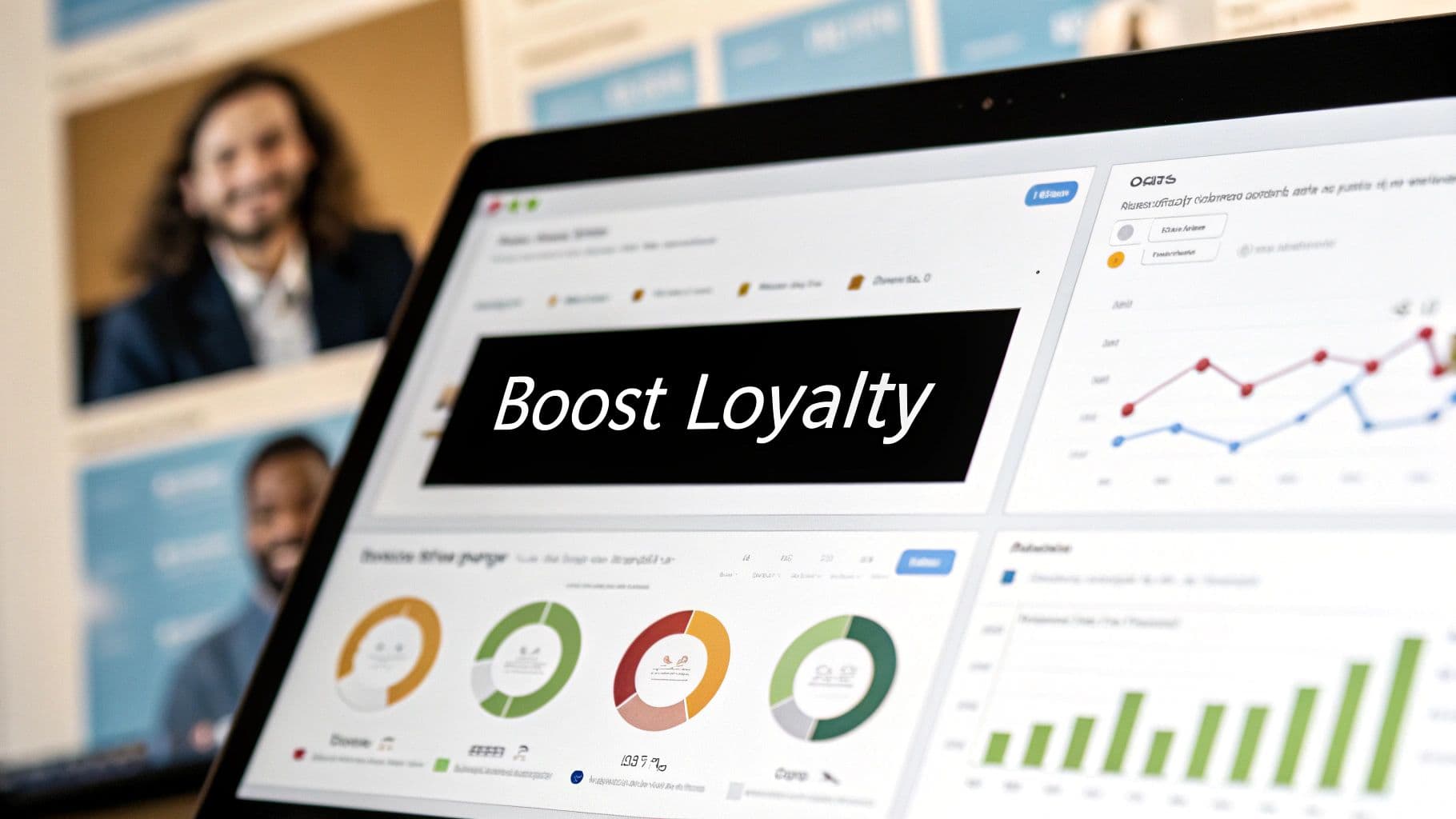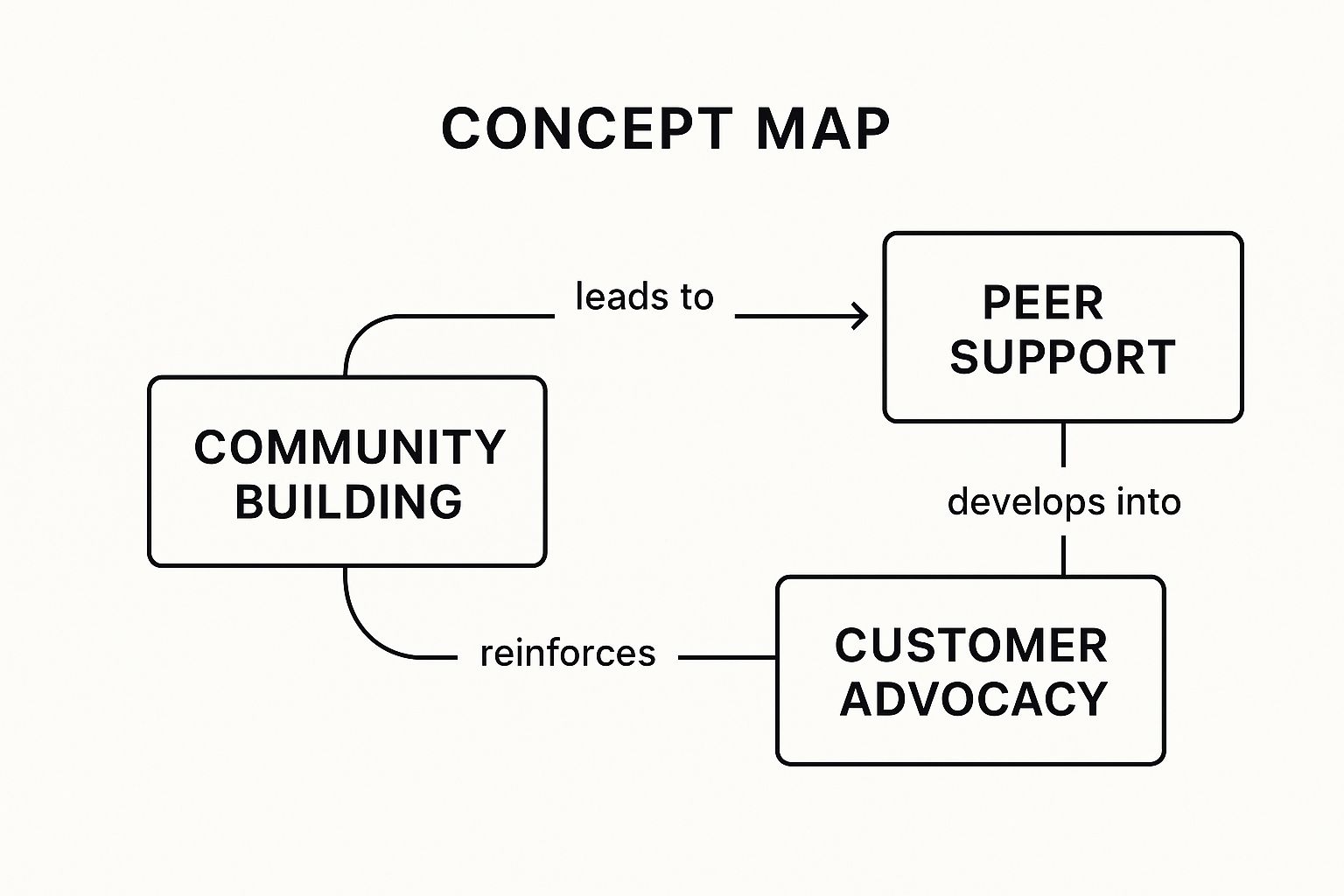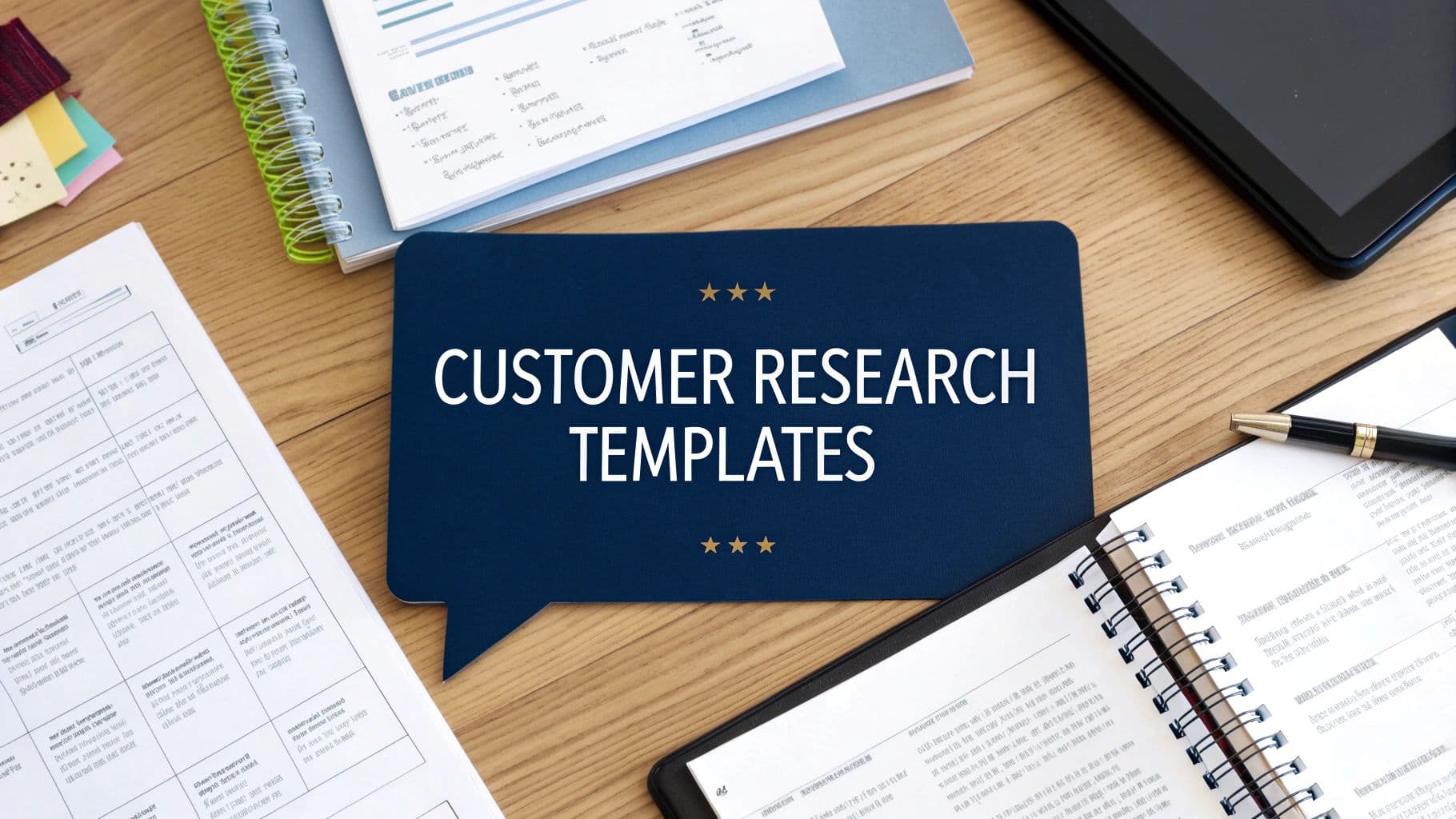Customer Retention Best Practices to Boost Loyalty
Explore effective customer retention best practices to reduce churn and grow your SaaS business. Get actionable tips today!

In the relentless pursuit of growth, SaaS companies often fixate on customer acquisition, celebrating new logos and monthly recurring revenue (MRR) expansion. Yet, this focus on "filling the top of the funnel" can obscure a more powerful, sustainable engine for growth: keeping the customers you already have. Acquiring a new customer can cost five times more than retaining an existing one, and a mere 5% increase in customer retention can boost profitability by 25% to 95%. The math is clear, but the execution requires a deliberate, strategic approach. This is where mastering customer retention best practices becomes a competitive advantage, transforming your business from a leaky bucket into a compounding growth machine.
This article moves beyond generic advice to provide a comprehensive roundup of actionable, high-impact retention tactics specifically for SaaS businesses. We will dissect nine critical strategies that product, support, and growth teams can implement immediately. From architecting a truly personalized customer experience and deploying proactive support models to leveraging predictive analytics for churn prevention, each point is designed to be a practical blueprint. You will learn not just what to do, but how to do it, with specific implementation details and real-world examples.
Forget surface-level tips. This guide offers a deep dive into creating robust feedback loops, building vibrant customer communities, and ensuring every communication reinforces your product's value. Whether you're a product manager refining the user journey or a customer success leader aiming to reduce churn, these proven methods will equip you to build lasting customer relationships that fuel long-term, profitable growth. Let's explore the essential practices that turn happy users into lifelong advocates.
1. Master Hyper-Personalization at Scale
Hyper-personalization is the practice of using real-time data and AI to deliver highly contextual and individualized content, products, and service interactions. It goes beyond using a customer's first name in an email. This is about leveraging behavioral data, in-app actions, and user preferences to create experiences so tailored they feel uniquely crafted for each individual. For SaaS companies, mastering this is a cornerstone of effective customer retention best practices because it demonstrates a deep understanding of user needs.
This advanced form of personalization makes users feel seen and valued, transforming their relationship with your platform from a simple tool into an indispensable partner in their success. When a user sees that your product adapts to their specific workflow or anticipates their next need, their loyalty and engagement skyrocket.
How to Implement Hyper-Personalization
Implementing this strategy requires a solid data foundation and the right tools. Start by unifying customer data from various touchpoints like your CRM, support desk, and the product itself into a single customer profile.
- Segment Dynamically: Move beyond static segments like "new users" or "power users." Create dynamic, behavior-based segments that update in real-time. For example, a segment could be "Users who have used Feature X three times this week but have not tried complementary Feature Y."
- Leverage In-App Messaging: Use the data to trigger personalized in-app guides or tooltips. If a user repeatedly performs a task manually, a pop-up could introduce them to a time-saving automation feature they haven't discovered yet. This proactive guidance improves their product experience and reinforces value.
- Tailor Communications: Personalize email campaigns and notifications based on feature usage. Instead of a generic newsletter, send a user-specific digest highlighting how they can get more from the features they already use or introducing new ones relevant to their past behavior.
For instance, a project management tool could personalize the dashboard to prioritize projects a user interacts with most frequently. Similarly, an e-commerce analytics platform might send a customized report highlighting metrics most relevant to a user's specific industry, demonstrating its direct value to their business goals and securing long-term loyalty.
2. Proactive Customer Support
Proactive customer support is the strategy of identifying and resolving customer issues before they escalate or are even reported. It involves shifting from a reactive "wait for the ticket" model to an anticipatory approach, using data to spot potential friction points and reaching out with solutions. For SaaS platforms, this is one of the most powerful customer retention best practices because it turns potential frustration into a positive, loyalty-building interaction.

This preemptive engagement demonstrates that you are invested in the customer's success, not just in closing their support tickets. When users receive help before they have to ask for it, it shows a deep understanding of their journey and reinforces the value of your service, significantly reducing the likelihood of churn.
How to Implement Proactive Customer Support
A successful proactive strategy is built on data monitoring and automated workflows. The first step is to leverage product analytics and customer health scores to identify early warning signs of trouble.
- Monitor Usage Patterns: Use data to flag at-risk accounts. For example, a sudden drop in feature usage, repeated failed actions, or a user who has stopped inviting new team members can all signal potential problems.
- Automate Outreach: Create automated workflows for common issues. If your system detects a user struggling with a new integration setup, trigger an automated email or in-app message offering a step-by-step guide or a link to book a call with a support specialist.
- Train for Early Recognition: Equip your support and success teams to recognize subtle cues during interactions. A user mentioning a minor annoyance could be an early indicator of a larger underlying issue that warrants a proactive follow-up.
- Build a Proactive Playbook: Develop a library of pre-written solutions, video tutorials, and help articles for common pain points. This enables your team to respond quickly and consistently when a potential issue is identified.
For example, a platform like HubSpot might notice a user’s email campaign has an unusually low open rate and proactively send them a guide on improving subject lines and deliverability. Similarly, Adobe can monitor for repeated software crashes for a specific user and reach out with a targeted patch or troubleshooting steps, preventing a support ticket and building immense goodwill.
3. Implement a Value-Driven Loyalty Program
A customer loyalty program is a structured marketing strategy designed to reward and encourage repeat business from existing customers. While often associated with B2C retail, a well-designed program is a powerful tool in the SaaS playbook, offering incentives and exclusive benefits that foster a deeper, more committed relationship with your user base. This is a critical component of customer retention best practices because it transforms transactional users into long-term brand advocates.
These programs formalize the customer relationship, providing tangible reasons for users to stay engaged and invested in your platform. Instead of simply using your product, they become members of an exclusive community, which significantly increases switching costs and emotional connection. For a SaaS company, this can mean rewarding continued subscription, high feature adoption, or even advocacy behaviors like referrals.
How to Implement a Loyalty Program
A successful SaaS loyalty program must go beyond simple transactional rewards. It needs to align with the value your users derive from your product. Start by identifying key behaviors that correlate with long-term retention and customer success.
- Align Rewards with Customer Value: Offer rewards that enhance their product experience. Instead of generic gift cards, provide early access to new features, premium support tiers, exclusive training webinars, or even free consultations with product experts. These rewards reinforce the value of your core offering.
- Keep it Simple and Transparent: The rules for earning and redeeming rewards should be crystal clear. Users should easily understand what actions to take and what benefits they will receive. A complex, confusing program will create frustration and disengagement, defeating its purpose.
- Tier the Experience: Create tiered levels (e.g., Bronze, Silver, Gold) that users can achieve based on their engagement, subscription length, or usage milestones. This gamifies the experience, providing a clear path for advancement and motivating users to deepen their product adoption to unlock greater benefits.
For example, an analytics platform could offer "data credits" or access to premium report templates for users who consistently log in and build dashboards. Similarly, a design tool like Canva rewards its community of creators through exclusive content and features, making them feel like valued insiders and ensuring they continue to build within its ecosystem.
4. Regular Customer Feedback Collection and Action
Regularly collecting and acting on customer feedback is the practice of systematically gathering, analyzing, and implementing changes based on user insights. This goes beyond an annual survey; it's about creating a continuous, closed-loop system where customers feel heard and see their input directly impact the product's evolution. For SaaS companies, this is a fundamental customer retention best practice because it aligns your roadmap with user needs, ensuring you build what people actually want and value.
This proactive approach transforms the customer relationship from a transactional one into a collaborative partnership. When users see their suggestions come to life or their frustrations addressed in a software update, it builds immense trust and loyalty. They become invested in your product’s success because they have a hand in shaping it, which significantly reduces the likelihood of churn.
How to Implement a Feedback Loop
Creating an effective feedback loop requires dedicated channels for collection and a clear process for action. The goal is to make providing feedback easy for the customer and to ensure that feedback is routed to the right teams internally.
- Use Multiple Touchpoints: Don't rely on a single method. Combine different channels like Net Promoter Score (NPS) surveys post-onboarding, in-app feedback widgets for contextual suggestions, and direct outreach from customer success managers to high-value accounts. This provides a holistic view of customer sentiment.
- Act and Communicate: The most critical step is closing the loop. When you implement a change based on feedback, communicate it back to the users who suggested it. A simple "You asked, we listened" email or update notification shows that you value their input and are actively improving the experience for them.
- Keep Surveys Short and Focused: Respect your users' time. Instead of long, complex questionnaires, use micro-surveys triggered by specific user actions. For example, after a user engages with a new feature for the first time, a one-question survey can capture immediate, relevant feedback. This increases response rates and gathers more targeted insights.
For instance, Microsoft’s Windows Insider Program allows engaged users to test new builds and provide direct feedback, which heavily influences feature prioritization and bug fixes. This not only improves the final product but also creates a powerful community of brand advocates. Similarly, using the right customer feedback analysis tools can help you categorize and prioritize thousands of user comments, turning raw data into an actionable product roadmap.
5. Implement Omnichannel Customer Engagement
Omnichannel customer engagement is the strategy of creating a seamless and integrated customer experience across all potential touchpoints and channels. This includes your SaaS platform, mobile app, email communications, live chat, social media, and customer support portals. It ensures that messaging, context, and service quality remain consistent, allowing users to transition between channels without losing their conversation history or progress.
This unified approach is a critical component of modern customer retention best practices because it removes friction and frustration from the user journey. When a customer can start a support ticket via live chat on their desktop and later add details via the mobile app without re-explaining their issue, they experience a cohesive, intelligent system that values their time. This level of service integration builds trust and makes your ecosystem feel indispensable.

How to Implement Omnichannel Engagement
Executing an omnichannel strategy requires centralizing customer data and aligning your teams. The goal is to create a single, unified view of the customer that is accessible across all departments and platforms, from marketing to support.
- Unify Customer Data: Invest in a Customer Data Platform (CDP) or a robust CRM to consolidate interaction data from every channel into a single customer profile. This ensures your support agent has the same context as your marketing automation system.
- Map Cross-Channel Journeys: Identify the common paths users take across different touchpoints. For example, a user might see a new feature announcement in an email, click to learn more on your blog, and then log into the app to try it. Optimize these transitions to be as smooth as possible.
- Train Teams for Consistency: Ensure all customer-facing teams, from sales to support, are trained to deliver a consistent brand voice and service quality, regardless of the channel they operate in. Equip them with access to the unified customer profile so they have full context for every interaction.
For example, Sephora’s app allows customers to scan products in-store to see online reviews and save them to a digital wish list, seamlessly blending the physical and digital shopping experiences. Similarly, a SaaS company could allow a user to start a conversation with a chatbot in-app and seamlessly transfer the full transcript and context to a human agent for more complex issues, preventing the user from ever having to repeat themselves.
6. Implement Proactive Customer Success Management
Customer Success Management (CSM) is a proactive business methodology focused on ensuring your customers achieve their desired outcomes while using your product. Far from being a reactive support function, CSM is a strategic partnership that guides users from onboarding through to full adoption and value realization. For SaaS businesses, a strong CSM function is one of the most powerful customer retention best practices because it transforms the customer relationship from a transaction into a long-term alliance.
This approach ensures customers are not just using your software, but are succeeding with it. By actively monitoring customer health and engaging with them at critical moments, you can address potential issues before they lead to frustration or churn, cementing your product's role as an essential part of their operations.
How to Implement Customer Success Management
Effective CSM requires a structured approach driven by data and a deep understanding of customer goals. It begins with establishing what "success" means for each customer and building a framework to help them achieve it consistently.
- Define Customer Success Milestones: Work with customers during onboarding to define their key business objectives and map them to specific product features and usage patterns. This creates a clear roadmap for value realization that your CSM team can guide them along.
- Develop Customer Health Scores: Create a data-driven health score by combining product usage data (like feature adoption and login frequency), support ticket volume, and qualitative feedback. This score provides an at-a-glance indicator of which customers are thriving and which are at risk. You can explore various user retention metrics on sigos.io to build a comprehensive score.
- Create Proactive Engagement Playbooks: Based on health scores and usage triggers, develop standardized playbooks for your CSMs. For instance, a drop in a key feature's usage might trigger a proactive check-in call to offer training or uncover a new business challenge the customer is facing.
For example, HubSpot's renowned customer success team engages with clients to ensure they are not just using the marketing automation tools but are actually increasing leads and conversions. Similarly, Salesforce's Trailhead program empowers users to master the platform, directly linking product proficiency with professional success and driving exceptional long-term retention.
7. Implement Value-Based Communication
Value-based communication is the strategic practice of framing all customer interactions around the specific outcomes, benefits, and ROI they receive from your product. It shifts the conversation from what your features do to what those features achieve for the customer's business. For SaaS companies, this is one of the most powerful customer retention best practices because it constantly reinforces your product’s role in their success.
This approach ensures that customers don't just see your platform as a line item on their expense report but as a vital engine for growth and efficiency. By consistently connecting your product to their core business goals, you build a powerful defense against churn and transform customers into advocates who understand and can articulate your product's tangible worth.
How to Implement Value-Based Communication
Transitioning to this model requires a deep understanding of your customers' objectives and the ability to quantify your impact. Start by defining the key value metrics for different customer segments, such as time saved, revenue generated, or costs reduced.
- Quantify and Share Success: Regularly send personalized reports or dashboard summaries that translate usage into tangible business outcomes. For example, a marketing automation tool could send a monthly email stating, "This month, you automated 3 campaigns, saving an estimated 15 hours of manual work."
- Create Industry-Specific Benchmarks: Develop case studies and benchmarks that show customers how their performance compares to peers in their industry. This not only demonstrates value but also provides aspirational goals they can achieve using your platform more effectively.
- Align Messaging with Business Goals: Tailor your communication to match the customer's current business cycle. If a customer is in a growth phase, focus your messaging on scalability and revenue generation. If they are focused on efficiency, highlight cost-saving features.
For instance, a platform like Salesforce might send a quarterly business review to an enterprise client with a custom-built ROI calculator showing exactly how much sales process efficiency has improved. Similarly, an e-commerce platform like Shopify regularly provides merchants with analytics dashboards focused on sales growth and customer acquisition costs, directly linking platform usage to their financial success.
8. Predictive Analytics for Churn Prevention
Predictive analytics involves using data science and machine learning algorithms to identify customers who are at high risk of churning before they actually leave. This proactive approach analyzes vast datasets, including customer behavior, usage patterns, and engagement metrics, to forecast the likelihood of cancellation. For SaaS companies, this is one of the most powerful customer retention best practices as it shifts retention efforts from reactive damage control to proactive, data-driven intervention.
By identifying at-risk users early, you can trigger targeted retention campaigns designed to re-engage them and demonstrate your product's value. This method allows you to allocate resources more effectively, focusing your efforts on the accounts that need attention the most, thereby preventing revenue loss and improving customer lifetime value.
How to Implement Predictive Churn Analytics
Building a predictive model requires a clean data pipeline and a clear strategy. Start by consolidating data from your product analytics, CRM, and support systems to create a comprehensive view of each customer's journey and health.
- Identify Key Churn Indicators: Analyze historical data from churned customers to find common patterns. Key indicators might include a decline in login frequency, decreased usage of core features, a drop in support ticket submissions, or negative feedback on surveys.
- Build and Test Models: Start with simpler models like logistic regression before moving to more complex machine learning algorithms. Different models may work better for different customer segments, so test and refine your approach continuously. To learn more about the specifics, you can explore various churn prediction models and their applications.
- Establish Action Protocols: A prediction is useless without a plan. Create clear, automated workflows for when a user is flagged as high-risk. This could trigger an email sequence from customer success, an in-app offer for a training session, or a direct outreach call to understand their challenges.
For example, a SaaS platform like Zendesk might predict churn when a team's ticket resolution time starts to increase, indicating they are struggling. In response, it could automatically trigger an in-app guide highlighting an underused automation feature that could solve their specific bottleneck, effectively preventing churn by proactively solving their problem.
9. Community Building and Customer Advocacy
Creating a vibrant community is about transforming your customer base from a collection of individual users into an interconnected network. This strategy involves building platforms where customers can share experiences, offer peer-to-peer support, and ultimately become advocates for your brand. For SaaS companies, fostering this sense of belonging is a powerful customer retention best practice because it embeds your product into a user's professional identity and support system.
When customers feel like they are part of something bigger, their relationship with your product deepens. A community provides a space for users to learn from each other, solve problems collaboratively, and feel connected to a shared mission. This creates powerful social proof and a moat around your business that competitors find difficult to replicate, directly increasing loyalty and reducing churn.
How to Implement Community and Advocacy Programs
Building a successful community requires a dedicated effort to foster engagement and provide value beyond just the product itself. Start by identifying and empowering your most passionate users to act as founding members or community champions.
- Provide a Central Hub: Establish a dedicated space for interaction, whether it's a forum on your site (using platforms like Discourse), a Slack or Discord channel, or a branded online community platform. This hub should be the go-to place for product questions, best practice sharing, and networking.
- Seed Value-Driven Content: Kickstart conversations with valuable content. This could include exclusive webinars with product experts, "ask me anything" sessions with your team, or user-generated content showcases. The goal is to make the community a source of indispensable knowledge.
- Formalize Advocacy: Create a structured advocacy program that recognizes and rewards contributions. This could involve offering beta access, company swag, or public shout-outs to members who answer questions, write case studies, or refer new customers.
The following concept map visualizes the powerful relationship between building a community, enabling peer support, and fostering genuine customer advocacy.

The visualization shows that community building directly enables peer support, which then cultivates customer advocacy, creating a virtuous cycle where advocates reinvest their energy back into the community. For example, Salesforce's Trailblazer Community allows users to help one another, which not only solves immediate problems but also creates a deep sense of loyalty and turns those helped into future helpers and brand champions.
Customer Retention Best Practices Comparison
| Item | Implementation Complexity 🔄 | Resource Requirements ⚡ | Expected Outcomes 📊 | Ideal Use Cases 💡 | Key Advantages ⭐ |
|---|---|---|---|---|---|
| Personalized Customer Experience | High - needs data analysis & tech integration | High - data, tech investment, maintenance | Increased conversion, loyalty, revenue, reduced churn | E-commerce, media streaming, retail marketing | Highly relevant offers & journeys |
| Proactive Customer Support | Medium to High - requires monitoring tools | Medium to High - monitoring & staff | Reduced frustration, fewer tickets, higher satisfaction | SaaS, tech support, subscription services | Prevents issues, improves satisfaction |
| Customer Loyalty Programs | Medium - program setup and management | Medium to High - operations & rewards | Increased repeat purchases, lifetime value, brand loyalty | Retail, hospitality, membership-driven models | Builds long-term customer engagement |
| Regular Customer Feedback | Medium - survey systems & analysis | Medium - survey tools & analysis teams | Identifies improvements early, boosts satisfaction | Customer experience management | Drives innovation & customer trust |
| Omnichannel Customer Engagement | High - complex integration & alignment | High - tech infrastructure & training | Seamless experience, higher conversions, greater brand loyalty | Retail, banking, large enterprises | Consistent cross-channel customer journey |
| Customer Success Management | High - dedicated teams & success tracking | High - human resources and tools | Reduced churn, better adoption, upsell opportunities | SaaS, B2B services | Strong customer relationships & retention |
| Value-Based Communication | Medium - tailored messaging & ROI tracking | Medium - content creation & analytics | Increased engagement, upselling, stronger customer relationships | B2B, strategic accounts | Emphasizes customer-specific value |
| Predictive Analytics for Churn | High - advanced data science & model upkeep | High - data infrastructure & expertise | Early churn detection, improves retention & resource allocation | Subscription services, SaaS | Data-driven proactive retention |
| Community Building & Advocacy | Medium to High - platform and moderation | Medium to High - community management | Strong brand connection, peer support, word-of-mouth marketing | Brands focusing on loyalty & advocacy | Builds emotional loyalty & reduces costs |
From Best Practices to Business as Usual
Navigating the landscape of customer retention can feel like assembling a complex puzzle. We've explored a comprehensive suite of strategies, from the foundational necessity of personalized experiences and proactive support to the sophisticated power of predictive analytics. Each piece, whether it's building a vibrant community, implementing a value-driven loyalty program, or establishing robust feedback loops, is a critical component of a larger, more resilient business structure. The journey from simply acquiring users to truly retaining them is a transformative one, shifting focus from a leaky bucket model to a flywheel of sustainable growth.
The core message weaving through all these tactics is simple: retention isn't a one-time initiative or the sole responsibility of a single department. It is a company-wide philosophy, a cultural commitment to delivering continuous value long after the initial sale. Adopting these customer retention best practices means embedding them into your daily operations until they become second nature, or "business as usual." It's about making customer-centricity the default setting for your product, support, and growth teams.
Your Roadmap to Enhanced Customer Loyalty
To move from theory to tangible results, it's crucial to distill these ideas into an actionable plan. Avoid the paralysis of trying to implement everything at once. Instead, focus on a strategic, phased approach that builds momentum and delivers measurable improvements over time.
Here are your immediate next steps:
- Conduct a Retention Audit: Before you can improve, you must understand your current state. Analyze your churn data, review customer feedback from the last six months, and map out your existing customer journey. Identify the most significant friction points and the moments where customers are most likely to lose sight of your product's value. Is the drop-off happening during onboarding, after a key feature is used, or simply due to a lack of ongoing engagement?
- Prioritize One Key Area: Based on your audit, select one or two high-impact practices to focus on first. If your data shows a steep drop-off within the first 30 days, perfecting your personalized onboarding process and implementing proactive support checks should be your top priority. If you're struggling with long-term engagement, launching a community or a tiered loyalty program might be the most effective starting point.
- Define and Measure Success: For your chosen initiative, establish clear Key Performance Indicators (KPIs). This isn't just about tracking your overall churn rate. Set more granular metrics, such as:
- For Onboarding: Time-to-first-value (TTFV), 30-day active user rate.
- For Feedback Loops: Net Promoter Score (NPS), Customer Satisfaction (CSAT), and the number of feature requests implemented.
- For Proactive Support: Reduction in support ticket volume for common issues, increase in positive support reviews.
Key Takeaway: The ultimate goal is to create a self-reinforcing cycle. By actively listening to your customers (feedback), anticipating their needs (predictive analytics), and consistently delivering value (product updates, proactive support), you build a loyal base of advocates who, in turn, attract new customers.
Mastering these customer retention best practices is more than just a defensive strategy against churn; it's the most powerful engine for offensive, profitable growth. A retained customer is not only a source of recurring revenue but also your most credible marketing asset. They provide invaluable feedback, become advocates for your brand, and create a stable foundation upon which you can innovate and scale your business with confidence. The investment you make in keeping your customers happy and successful will always yield the highest returns.
Ready to turn reactive support into proactive success? Many of the customer retention best practices we've discussed, especially predictive analytics and proactive outreach, rely on a deep understanding of customer behavior. SigOS provides the product intelligence platform to do just that, helping you identify at-risk users and uncover growth opportunities before your competitors do. Explore how SigOS can help you build a more resilient, customer-centric business.


